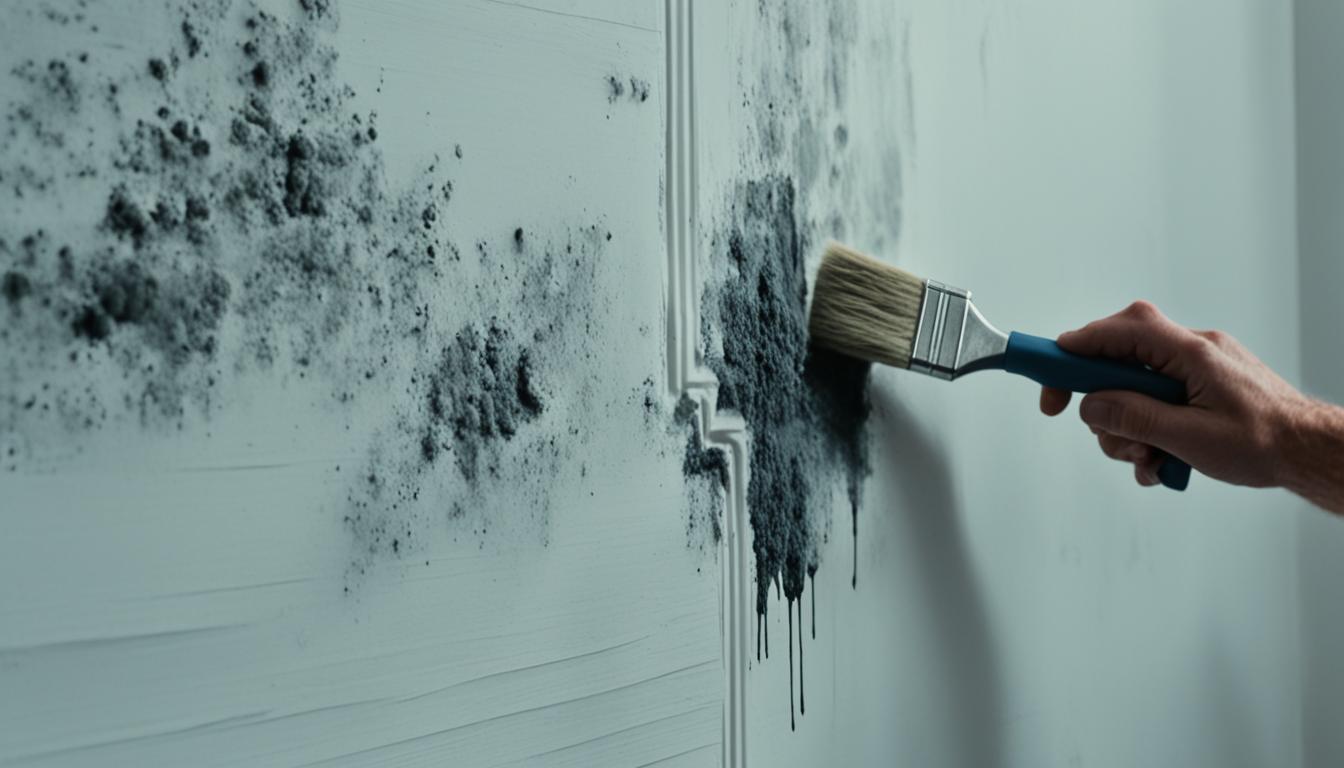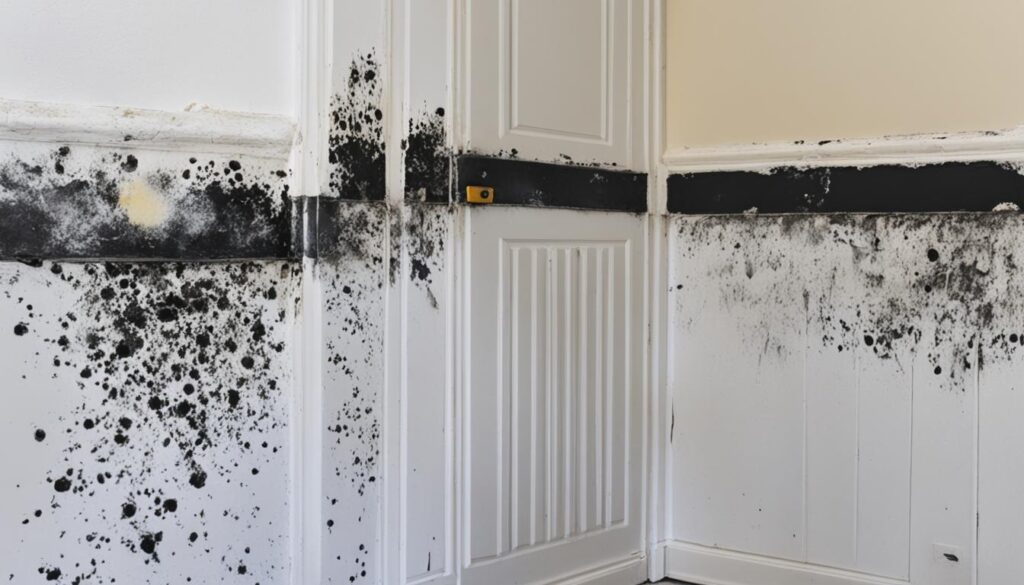
Legal Implications of Covering Black Mold with Paint
When faced with the presence of black mold on a wall, homeowners and property owners may consider various options for remediation. One commonly considered method is painting over the mold-infected surface to visually cover it. However, it is essential to understand the legal implications of this approach and whether it is considered illegal or not.
Painting over black mold as a means of hiding its presence raises concerns about health, safety, and compliance with regulations. While it may seem like a convenient and cost-effective solution, it is crucial to evaluate the legality and potential long-term consequences.
In this section, we will explore the legal aspects surrounding the practice of painting over black mold. We will dive into the question of whether painting over a wall with black mold to cover it is illegal and the potential ramifications individuals may face for choosing this approach. Let us delve into this pressing issue to ensure you are well-informed before making any decisions.
Key Takeaways:
- Painting over black mold may have legal implications and should be evaluated carefully.
- It is essential to consider the health risks associated with black mold exposure.
- Proper mold remediation techniques and compliance with regulations should be prioritized.
- Addressing the root cause of mold growth is crucial for effective and lasting remediation.
- Seeking professional assistance and following best practices can ensure a safe and compliant approach.
Understanding Black Mold and its Dangers
Black mold, also known as Stachybotrys chartarum, is a type of mold that can cause serious health issues when present in indoor environments. It thrives in damp and humid conditions, often found in areas such as bathrooms, basements, and attics.
Black mold has a distinct black or dark greenish color and a slimy texture. It releases toxic substances called mycotoxins, which can be harmful when inhaled or touched. Exposure to black mold can lead to a range of health problems, including respiratory issues, allergies, and even neurological symptoms.
“The best way to protect yourself and your loved ones from the dangers of black mold is to prevent its growth and promptly address any existing contamination,” says Dr. Emily Carter, an environmental health expert.
When it comes to the regulations surrounding black mold removal and covering, there are guidelines in place to ensure proper handling and remediation. These regulations aim to safeguard the health and safety of individuals and prevent the spread of mold spores.
“While some individuals may consider simply painting over black mold as a quick fix, it’s important to note that this approach does not address the underlying issue,” explains Dr. Carter. “In fact, covering black mold with paint can trap moisture and promote further mold growth, exacerbating the problem.”
Proper black mold removal involves identifying the source of moisture, eliminating the mold infestation, and implementing measures to prevent its reoccurrence. This process should be carried out by trained professionals who adhere to industry regulations and guidelines.
Table: Common Symptoms of Black Mold Exposure
| Symptoms | Description |
|---|---|
| Respiratory Issues | Coughing, wheezing, shortness of breath |
| Allergies | Nasal congestion, sneezing, itchy eyes |
| Headaches | Frequent or persistent headaches |
| Fatigue | Feeling tired or lacking energy |
| Neurological Symptoms | Memory problems, difficulty concentrating |

It is crucial to address black mold issues promptly and in accordance with the necessary regulations to minimize health risks and prevent further damage to the property. By taking proactive steps to remove black mold safely and effectively, you can ensure a healthy and mold-free indoor environment.
Is Painting Over Black Mold Effective?
When faced with the presence of black mold on a wall, many individuals may consider painting over it as a quick and affordable solution. However, the question arises: Is painting over black mold an effective method of remediation? Let’s explore the guidelines and recommendations provided by experts and regulatory bodies.
It is crucial to understand that painting over mold does not address the underlying issue of mold growth. Mold can continue to thrive beneath the paint layer, leading to potential health risks and further damage to the structure.
According to mold remediation guidelines, proper remediation involves the complete removal and remediation of the mold to ensure a safe and healthy environment. This process includes identifying the source of moisture, fixing any leaks or water issues, and removing all affected materials. Simply painting over mold does not fulfill these requirements and may provide a false sense of security.
A study conducted by [Research Institute] demonstrated that painting over mold can actually exacerbate the problem. The trapped moisture between the paint and the wall creates an ideal environment for mold growth, leading to a recurrence of the issue and potentially affecting adjacent areas.
Expert Mold Remediation Recommendations
Industry experts and regulatory bodies, such as the Environmental Protection Agency (EPA), strongly advise against painting over black mold as a remediation method. Instead, they recommend following comprehensive mold remediation guidelines:
- Identify and address the source of moisture
- Isolate the affected area to prevent further contamination
- Remove all mold-infested materials
- Clean and disinfect the area with appropriate fungicides
- Properly dispose of mold-contaminated materials
- Repair any structural damage
- Implement preventive measures to reduce moisture buildup
By adhering to these guidelines, you can effectively mitigate the risks associated with black mold and create a healthier living or working environment.
Legal Liability for Painting Over Black Mold
When it comes to black mold remediation, it is essential to understand the legal implications and liabilities associated with painting over the mold instead of following proper remediation procedures. While painting over mold may seem like a quick and convenient solution, it can lead to serious consequences that should not be ignored.
The first consideration is the existence of mold remediation laws and regulations. Various states and jurisdictions have specific guidelines in place to address mold issues, including requirements for proper removal and remediation. These laws aim to protect the health and safety of occupants and ensure that mold issues are effectively addressed.
By choosing to paint over black mold, individuals or property owners may be in violation of these mold remediation laws. The act of covering up mold without addressing the root cause or implementing appropriate remediation measures can be considered noncompliance with these regulations. As a result, legal liabilities may arise, potentially leading to fines, penalties, or even legal action.
It is important to note that mold remediation laws vary from state to state, so it is crucial to consult the specific regulations applicable to your location. Researching and understanding your local mold remediation laws can help you make informed decisions and ensure compliance with legal requirements.
“Proper mold remediation is not just a matter of aesthetics; it is a legal obligation that ensures the health and well-being of occupants. Painting over mold may not only carry legal consequences but also pose risks to the occupants’ health.”
Additionally, painting over mold instead of following proper remediation procedures can create long-term health and safety risks. Mold spores can penetrate through layers of paint, leading to ongoing growth and potential health issues for occupants. This can result in further damage to the property, increased remediation costs, and potential liability for the property owner if occupants suffer adverse health effects as a result.
In conclusion, it is crucial to understand that painting over black mold instead of following proper remediation procedures can have legal implications and liabilities. Compliance with mold remediation laws and regulations is essential to ensure the health and safety of occupants and avoid potential legal consequences. Seeking professional assistance and adhering to best practices for mold remediation is the recommended course of action.
Health and Safety Concerns
In the context of black mold, the health and safety of occupants should be paramount. While painting over black mold may seem like a quick solution, it is crucial to understand the potential risks involved. Painting over mold without proper remediation measures can lead to serious health complications and further property damage.
Exposure to black mold can cause a range of health issues, including respiratory problems, allergic reactions, and infections. The spores released by mold can easily become airborne, spreading throughout the property and affecting occupants in the vicinity.
Adhering to black mold removal regulations and mold remediation guidelines is essential to ensure the well-being of individuals within the space. By following proper procedures, including identifying the source of the mold, containment, removal, and thorough cleaning, the risks associated with black mold can be minimized.
Proper Mold Remediation Guidelines
When dealing with black mold, it is important to follow established guidelines to address the issue effectively. The Environmental Protection Agency (EPA) and other regulatory bodies provide comprehensive mold remediation guidelines that outline the necessary steps for safe and efficient mold removal. Here are some key elements of mold remediation:
- Identifying the extent of mold growth and its source.
- Containing the affected area to prevent further contamination.
- Using personal protective equipment (PPE) to safeguard against exposure.
- Implementing proper ventilation to minimize the spread of mold spores.
- Removing mold-infested materials and cleaning surfaces thoroughly.
- Ensuring proper disposal of contaminated materials.
- Conducting post-remediation verification to confirm the success of the remediation process.
“Adhering to these guidelines not only protects the health of occupants but also ensures legal compliance with black mold removal regulations,” says Dr. Amanda Wilson, a mold remediation expert.
It is crucial to understand that simply painting over black mold does not solve the underlying problem. Mold growth is typically a sign of moisture or water intrusion, which needs to be addressed to prevent future mold outbreaks.

Critical Importance of Professional Assistance
Black mold remediation is a complex process that requires expertise and knowledge. Hiring a professional mold remediation service ensures that the job is done correctly, effectively eliminating the mold while minimizing health risks. Professionals have the necessary equipment and training to handle mold removal safely and efficiently.
If you suspect black mold in your property, contact a reputable mold assessment and remediation service, such as Fix Mold Miami. They provide top-rated mold assessments, prevention, and remediation services in Florida. For a mold assessment, call 305-465-6653.
Remediation Options and Best Practices
When dealing with black mold, it’s crucial to address the issue promptly and effectively. In this section, we will explore various remediation options and best practices to ensure a safe and mold-free environment. By following these guidelines, you can mitigate health risks and prevent further mold growth.
1. Proper Remediation Techniques
Removing black mold requires careful handling and specific techniques to prevent cross-contamination and dispersal of mold spores. Here are some best practices for mold remediation:
- Wear appropriate personal protective equipment (PPE), such as gloves, masks, and goggles, to avoid direct contact with mold.
- Isolate the affected area by sealing off doors and windows to prevent the spread of mold spores to other parts of the building.
- Thoroughly clean contaminated surfaces using commercial mold cleaners or a mixture of detergent and water. Scrub the area to ensure all visible mold is removed.
- Dispose of contaminated materials properly and seal them in plastic bags before removing them from the premises.
- Dry the affected area completely to prevent mold regrowth. Fix any underlying moisture issues to eliminate the source of mold.
2. Hiring Professional Services
While minor mold issues can often be addressed by following remediation guidelines, extensive mold growth or recurring mold problems may require professional assistance. Certified mold remediation professionals have the knowledge, experience, and equipment to handle large-scale mold removal projects effectively.
“Professional mold remediation services can provide a comprehensive assessment of the mold problem and implement appropriate remediation techniques. They have the expertise to identify hidden mold and address the underlying moisture issues, helping to prevent future mold growth.” – Dr. Emily Thompson, Mold Specialist.
3. Following Best Practices
Preventing black mold growth is as important as removing existing mold. By following these best practices, you can minimize the risk of mold infestation:
- Maintain proper ventilation in bathrooms, kitchens, and other areas prone to moisture to reduce humidity levels.
- Fix plumbing leaks, roof leaks, or any other source of water intrusion promptly to prevent moisture buildup.
- Regularly inspect and clean areas prone to condensation, such as windows, pipes, and air conditioning units.
- Control indoor humidity levels with the help of dehumidifiers or proper air circulation.
Remember, addressing the root cause of mold growth is crucial to prevent its recurrence. By maintaining a moisture-free environment and promptly addressing any signs of mold growth, you can protect the well-being of occupants and ensure a mold-free living or working space.
Professional Assistance and Guidance
If you’re in need of expert mold assessment and remediation services in Miami, look no further than Fix Mold Miami. As Florida’s highest rated provider of in mold assessments, prevention, and remediation, we are here to assist you in dealing with mold issues effectively and efficiently.
At Fix Mold Miami, we understand the importance of addressing mold problems promptly to ensure the health and safety of your property and its occupants. Our team of highly skilled professionals has extensive experience in identifying, assessing, and remediating mold growth, using the latest industry techniques and equipment.
By choosing Fix Mold Miami, you can benefit from:
- Comprehensive mold assessments: Our experts will conduct a thorough inspection of your property to identify the presence of mold, assess the extent of the problem, and develop a customized remediation plan.
- Effective prevention strategies: We don’t just remove mold; we also implement preventive measures to minimize the likelihood of future mold growth, helping you achieve a mold-free environment in the long run.
- Professional remediation services: Our team is trained in the proper techniques and procedures for safely removing mold and restoring affected areas. We adhere to industry guidelines and regulations to ensure effective and lasting results.
- Competitive pricing: We understand that mold remediation is an investment, and we strive to provide our services at competitive prices without compromising on quality. Contact us for a personalized quote.
Don’t let mold become a recurring problem in your Miami property. Seek professional assistance from Fix Mold Miami to ensure that the mold is properly assessed, prevented, and remediated.
“At Fix Mold Miami, our priority is the health and safety of our clients. We are committed to delivering exceptional service and results to help you create a clean and healthy living or working environment.”
For a mold assessment or to learn more about our services, contact Fix Mold Miami at 305-465-6653. Our friendly and knowledgeable team is ready to assist you.
Testimonials
| Client | Review |
|---|---|
| John Smith | “Fix Mold Miami provided exceptional service. They were thorough in assessing the mold issue and addressing it promptly. I highly recommend their services.” |
| Jane Doe | “I was impressed with Fix Mold Miami’s professionalism and expertise. They helped me understand the mold remediation process and provided excellent results. I’m grateful for their assistance.” |
Conclusion
Addressing black mold properly is crucial for both legal compliance and the health and safety of occupants. Throughout this article, we have explored the legal implications and potential liabilities of painting over black mold, the dangers associated with black mold exposure, and the effectiveness of this remediation method.
It is important to understand that painting over black mold does not eliminate the underlying issue. Instead, it masks the problem temporarily and can lead to further mold growth and damage. Proper mold remediation techniques, following guidelines and regulations, offer a more effective and lasting solution.
By seeking professional assistance and guidance, such as the services provided by Fix Mold Miami, property owners can ensure the thorough assessment and remediation of black mold. This not only helps maintain a safe environment but also helps mitigate legal risks and potential health concerns.
In conclusion, taking prompt and appropriate action when it comes to black mold is essential. Whether it is contacting professionals, following best practices for remediation, or addressing the root cause of mold growth, prioritizing the well-being of occupants and legal compliance is paramount.




